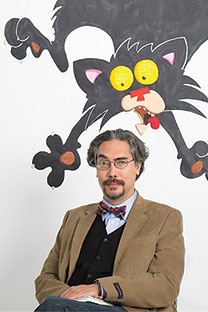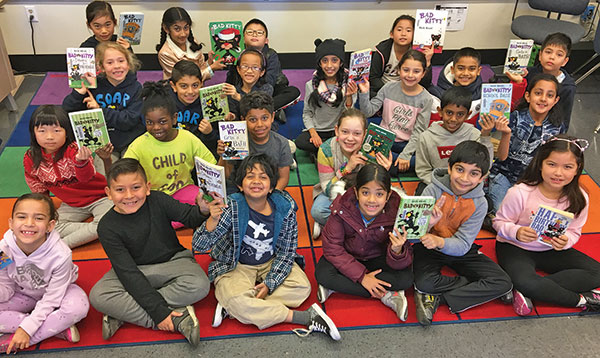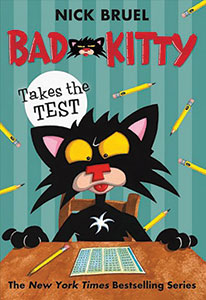
Mr. Hammond’s 2nd graders at Oliveira Elementary School in Fremont are big fans of the Bad Kitty books. They questioned best-selling author Nick Bruel about his creations exclusively for Kid Scoop News.
 Q: What made you write the Bad Kitty books?
Q: What made you write the Bad Kitty books?
A: Hi, Jane. I had wanted to write books for children for a long time. About 15 years ago, I was sitting at home and thinking of interesting titles for books. Just titles. I wasn’t even thinking of stories yet.
After a while and after writing down several titles, I came up with Bad Kitty. I had never seen a book with that title, so I decided to start contemplating what a story with that title would look like. I knew it had to be a story about a cat doing something bad, but what? The more I thought about it, the more interesting ideas I came up with.
I thought it would be in neat if I put those ideas, those “bad” things that cat would do into alphabetical order. Then I thought about the reasons the cat would do so many awful things. A cat’s behavior is often influenced by food, so I thought it would be neat if I made an alphabet of foods the cat didn’t like. And that’s how the very first Bad Kitty book took shape. In my case, the title came first, even before the story.
Q: How do you make the books so funny?
A: Hi, Aarush. When I’m writing my stories, I often ask myself this very important question: “Is this funny?” If the answer I give myself is “no,” then I start over again. If the answer I give myself is “maybe,” then I STILL start over again. I keep asking myself this question until I give myself the answer “Yes! This is funny.” But I do try to have serious moments in each of my books. If I made my stories only funny, then I think they would become boring very quickly. And just as importantly, I would become bored writing them.
Q: Why is Bad Kitty so horrible and crazy?
A: Hi, Armani. I don’t think so much of Kitty as being horrible and crazy herself. But I do think that from Kitty’s point of view, horrible things happen to her and the only way for her to react is to go crazy. For instance, when Uncle Murray comes to housesit, Kitty sees this as a horrible thing and this drives her crazy. Kitty has to go to school; she thinks this is a horrible idea and it drives her crazy.
I do try to have serious moments in each of my books. If I made my stories only funny, they would become boring very quickly.
Q: How do you come up with so many ideas?
A: Hi, Sai. What I’m going to tell you is true not only for me but for anyone who writes or creates stories or artwork or anything creative. I think the most important thing you need in order to find ideas is a quiet place or a quiet routine in which you can contemplate your ideas without distractions. I have an office in which I go to do my work. If there are distractions, I close my door. But sometimes I come up with ideas by taking a long, quiet walk. Sometimes I get my best ideas when I’m taking a shower or lying in bed or reading a book. Ideas come to different people in different ways. The important thing is to find that place or that routine in which you can think of your ideas without distractions.
Q: Where did you learn to write?
A: Hi, Atharva. Much like you, I learned to write while I was in school. And I suspect that I’m much like you in that I started writing my first stories when I was your age. But I also liked writing stories at home and especially while we were on vacation and there was nothing else to do. I had friends who I teamed up with to make our own comic books after school. I think I can easily trace what I do now as a career back to what I was doing when I was your age and creating stories purely for the joy of it.

Mr. Hammond’s Second Graders at Oliveira Elementary School in Fremont.
Q: How do you make sure your books are interesting to readers so they want to read more?
A: Hi, Amaya. This is a very important question and one I ask myself every single time I begin writing a new book. One thing I do to keep each book fresh is to pick a very different theme to each, something unique that I haven’t covered before. Happy Birthday, Bad Kitty is about birthdays. Bad Kitty vs. Uncle Murray is about babysitting. Bad Kitty For President is about how we go about electing a president in our country. Bad Kitty: Kitten Trouble is about getting along with others. I try very hard to make each book distinct from all the others.
 Q: Do you always do your own illustrations? How do you make them so detailed?
Q: Do you always do your own illustrations? How do you make them so detailed?
A: Hi, Gwen. I do. I’m very lucky that I’m able to illustrate my own stories. I don’t even think of myself as an artist. I think of myself as a writer who uses both words and pictures to tell a story. As for the details, like so many things in life those come with practice. I’ve been drawing all my life and every time I sit to make a drawing I learn a little bit more about what I’m doing. That’s practice. I think I’m a much better illustrator now than I was when I made the very first Bad Kitty book 15 years ago.
Q: Where did you get the idea to add Puppy into the story?
A: Hi, Shreya. Puppy appears on the last two pages of the very first Bad Kitty book. I created him because I needed a good ending for my story. This was the one in which Kitty didn’t get the food she wanted (in alphabetical order), so she performed all sorts of acts of mayhem (in alphabetical order), until she did get the food she wanted (in alphabetical order), and made amends (in alphabetical order). I could have ended the story there, but I wanted to make her bad again. The only problem was that what made her bad in the first place was not getting the food she wanted, but now she HAD the food she wanted. I needed something even more annoying. And that’s when I thought of Puppy. And thank goodness I did. Puppy is an extremely important character. The only character other than Kitty herself who appears in every single Bad Kitty book is Puppy. Many of my stories would not exist if not for Puppy.
Q: What other authors inspire you?
A: Hi, Ari. I’m friends with a great man named Jules Feiffer. His is the career I would most like to have for myself. He was a long time cartoonist for the Village Voice and even won a Pulitzer Prize for his work. He’s written and illustrated many books for both kids and adults. He’s written plays that have been on Broadway. He’s written the screenplays to some of my favorite movies. He’s even the illustrator of one of the greatest novels ever created: The Phantom Tollbooth, written by Norton Juster. Jules turned 90 in late January. I’m very happy I could be at his 90th birthday party!
Q: Did you always want to be a writer?
A: Hello, mystery interviewer. There were many things I wanted to be when I was a kid.
 I wanted to be a doctor, and I even grew up to enter college on a pre-med program, which would have put me onto the pathway to become one.
I wanted to be a doctor, and I even grew up to enter college on a pre-med program, which would have put me onto the pathway to become one.
I also remember wanting to be a doorman. I think being a doorman is pretty cool. You’re always helping people by holding the door open for them or helping them with their packages or hailing them a taxi. I remember being a kid and really liking that idea. I still do.
But I also wanted to be a cartoonist. I wanted to have a comic strip in the newspaper, because I could not think of a better job than writing and illustrating a little story every day that would be seen by thousands of people in the newspaper. And today, I do that … sort of. My stories are a little longer. They don’t appear in newspapers but inside books that can be found inside book stores and libraries. They can be seen all over the world.
I am living my dream even though this is not precisely the dream I had for myself when I was young.
If you’re a fan of the Bad Kitty books, be sure to join the Bad Kitty Club. Visit www.BadKittyBooks.com. You’ll need a parent’s permission.

